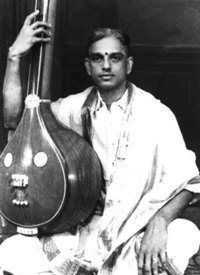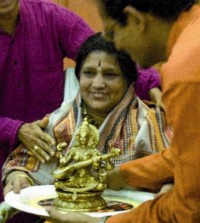COVER STORY

G.N. BALASUBRAMANIAM (1910-1965)
A genius and a pathbreaker
- V. RAMNARAYAN
He was among the most imitated vocalists in Carnatic music. Not only did some of his students start out, understandably, as carbon copies, many young musicians to this day try to mimic his inimitable style. India’s midnight’s children and younger citizens are unfortunately too young to have heard him live extensively, but some retain a few vivid images from childhood, and remember being exhilarated by his wonderful voice. Much of what we present here of Gudalur Narayanaswami Balasubramaniam, we owe Sruti’s articles and the GNB workshop, a brilliantly original effort in late 1992. Lalitha Ram, a die-hard fan and biographer of GNB, and a commemorative volume being brought out by the GNB family (with important contributions from several musicians, critics and rasika-s) have been other valuable sources.
Issue 7 of Sruti (1 May 1984) profiled GNB, carrying the following articles: GNB and his Great New Bani by P.N. Venkatraman; GNB: A Garland of Anecdotes by K.S. Muthuraman; and GNB: His Mind and Art by T.S. Vedagiri.
Born to G.V. Narayanaswami Iyer and Visalakshi on 6 January 1910, Balasubramaniam, called Mani at home, studied at the Hindu High School, Triplicane, Madras, Madras Christian College (where he completed his B.A. Honours in English), and briefly at Annamalai University. (A detailed biography is being serialised in Sruti, this issue carrying the fourth instalment of the story). GNB was eager to pursue a career in music, while his schoolmaster and music enthusiast father wanted him to take up a proper job. Mani had a natural flair for music and did not undergo rigorous gurukulavasam, though he did have lessons from Madurai Subramania Iyer and Karur Chinnaswami Iyer. Both his parents were musically talented and had many opportunities of listening to giants like Fiddle Tirukkodikaval Krishna Iyer, Flute Sarabha Sastri, Nagaswaram Tirumarugal Natesa Pillai and Harikatha expert Tiruppayanam Panchapakesa Sastrigal. When GVN, as Narayanaswami Iyer was often called, became a maths teacher at the Hindu High School, and became involved in the Sri Parthasarathi Swami Sabha, he came into close contact with great musicians. GNB recalled in a 1967 article, “Violinist Karur Chinnaswami Iyer lived next door to us in Triplicane. I lived in an atmosphere drenched in music and this helped me to nurture, develop and sustain my ardour for music.” His kelvi gnanam was sharp and inspired, enabling him to learn the more advanced aspects of music without the help of a guru. In his own words, “Without so much as any basic training, I acquired swara gnana which I humbly feel was due to the benediction of elders and savants. Whenever I listened to good music, I had an inner feeling that I could visualise it in the imagery of swara-s. What my ears would be hearing would be picturised in my mind’s eye in swara forms.”
HERITAGE

The Season - 75 years ago
The December Music Season of 1934 - SRIRAM. V
The Season of 1934 was relatively uneventful, barring a couple of minor episodes. The two principal players were the Music Academy and the Indian Fine Arts Society (IFAS) (see box titled The Sabhas in 1934) and the music festival of the sabha-s began within a day of each other. Both followed the same pattern, with a ceremonial inauguration by a prominent personality and a person deeply involved with music presiding over the annual conference. There were concerts every afternoon and evening.
The Academy released a series of advertisements in the press from as early as October 1934, giving details of its programmes. A small but significant change had taken place in the way the Academy saw its annual festival. Till 1933, the morning sessions or deliberations were of prime importance and the evening concerts were merely to showcase how music could be presented, keeping in mind the various ‘improvements’ that the Academy desired (read – no upapakkavadyam-s, no nagaswaram, no long drawn pallavi and concert duration not to exceed two-and-a-half hours). These were therefore called ‘model concerts’. But the IFAS had no such pretensions and organised concerts in the time-tested fashion, often with senior and popular artists and larger audience attendance. The Academy then decided to modify its approach and the advertisement released on 20th December in The Hindu said, “A Grand Carnival of Music” in much larger type than “Music Conference 1934”. Instrumental music was given importance and there were concerts featuring the flute, the violin, the veena, the gotuvadyam, the gettuvadyam, the jalatarangam, the sitar and the nagaswaram. The nagaswaram in particular had been a strict no-no on the Academy stage and was now making a triumphant comeback (see The Return of the Nagaswaram).
TRIBUTE

SUNDARI SANTHANAM
She fought cancer to pursue her passion - DR. SHOBHA SHASHIKUMAR
Sundari Santhanam passed away on 24th August 2009 in Bangalore at the age of 60 after battling cancer for many years, but she continues to live through her contributions to dance. Sundari was an ‘iron lady’ who designed and determined her own lifestyle. She embellished her life with simple and meaningful values. She remained an undiscovered jewel for a major part of her life. She was moulded in the true gurukula sampradaya by her legendary guru Dr. Padma Subrahmanyam. Sundari and her sister Uma were the two major disciples on whom Padma worked in order to arrive at the karana-s – a very time consuming, physically taxing and meticulous process. Padma publicly praised Sundari’s “patience, perseverance and dedication during the reconstruction of the marga karana-s of the Natya Sastra”, saying she had taken to task every limb of Sundari. Not every student could be as loyal and dedicated as Sundari who, till her last breath, attributed her work in the field of dance to the blessings of her guru.
She was very affectionate towards her students, but a tough taskmaster as a teacher. She was a perfectionist who was not easily pleased. However, she had all the patience in the world to correct her students till they got it right. As she was strict and uncompromising, she did not attract a large number of students. Initially she even faced hostility and contempt. In later years, many celebrity dancers sought her guidance, but she was not overwhelmed by their status. If today the technique of karana has found application in Karnataka, the credit goes to Sundari Santhanam, as everyone interested in the karana-s cannot go to Chennai to learn from the pioneer Padma Subrahmanyam.


